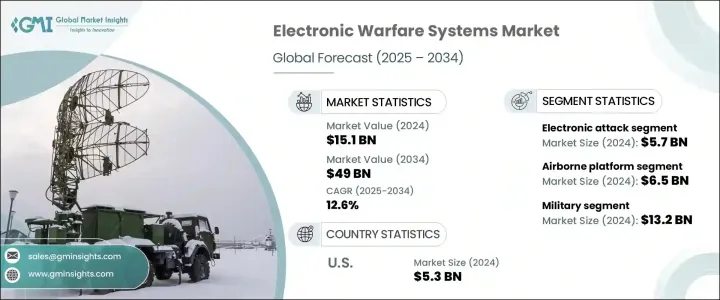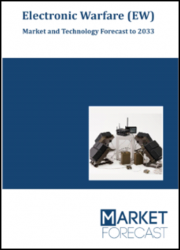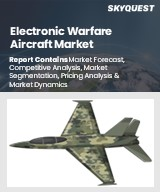
|
시장보고서
상품코드
1755189
세계의 전자전 시스템 시장 : 기회, 성장 촉진요인, 산업 동향 분석 및 예측(2025-2034년)Electronic Warfare Systems Market Opportunity, Growth Drivers, Industry Trend Analysis, and Forecast 2025 - 2034 |
||||||
세계의 전자전 시스템 시장 규모는 2024년 151억 달러로 평가되었고, 2034년 490억 달러에 이를 것으로 예측되며, CAGR 12.6%로 성장할 전망입니다.
이러한 성장은 전 세계 국방 예산의 증가, 현대화 이니셔티브의 강화, 네트워크 중심 및 사이버 전쟁 환경의 복잡성 증가에 의해 촉진되고 있습니다. 전 세계 군대는 상황 인식을 강화하고, 통신을 보호하며, 적의 시스템을 실시간으로 무력화하기 위해 전자전 시스템을 핵심 작전에 통합하고 있습니다. 무인 시스템의 채택이 확대되고 드론 및 레이더 네트워크를 비롯한 첨단 위협에 대응할 필요성이 높아짐에 따라 이러한 기술에 대한 수요가 더욱 증가하고 있습니다. 군이 전 영역에서의 우위와 다중 영역 작전을 우선으로 삼고 있는 상황에서 EW 시스템은 이제 공중, 해상, 육상, 우주, 사이버 공간에 이르기까지 모든 전투 영역에서 중요한 구성 요소가 되었습니다.

무역 정책도 공급망의 재편에 중요한 역할을 했습니다. 특정 전자 제품의 수입 제한으로 RF 모듈, 반도체, 회로 기판 등 부품의 가격이 크게 상승했습니다. 이러한 조치로 인해 방위 산업체들은 해외 기업에 대한 의존도를 낮추기 위해 국내 공급업체와 동맹국 공급원을 찾는 등 조달 전략을 전환했습니다. 이로 인해 일시적으로 비용이 급증했지만, 이러한 재편은 장기적인 자립과 생산의 안정성을 촉진하고 있습니다.
| 시장 범위 | |
|---|---|
| 시작 연도 | 2024년 |
| 예측 연도 | 2025-2034년 |
| 시작 금액 | 151억 달러 |
| 예측 금액 | 490억 달러 |
| CAGR | 12.6% |
전자 공격 시스템 부문은 2024년에 57억 달러의 매출을 올렸습니다. 현대의 전투 환경에서 UAV의 사용이 증가함에 따라 GPS 스푸핑 및 RF 재밍 솔루션에 대한 필요성이 더욱 높아지고 있습니다. 전자 공격 시스템은 이제 적의 드론을 무력화하고, 적의 레이더를 억제하며, 스텔스 작전을 지원하는 데 핵심적인 역할을 합니다. 고출력 마이크로파 및 레이저 기반의 지향성 에너지 무기의 수요가 증가함에 따라 적의 중요 인프라를 무력화하기 위해 설계된 차세대 시스템에 대한 투자가 가속화되고 있습니다.
항공 플랫폼은 2024년에 65억 달러의 가치를 기록하며 가장 큰 시장 부문을 차지했습니다. 이 플랫폼들은 이동성, 확장된 작전 범위, 실시간 교전 중 고급 대응 조치를 제공할 수 있는 능력으로 인해 필수적입니다. 전자 대응 포드, 레이더 방해 장치, 신호 위조 장치가 전투기, 무인 항공기(UAV), 감시 항공기에 통합되어 고기술 위협에 대응하고 있습니다. 이러한 시스템은 공중 우세 달성에 필수적이며 다영역 전쟁 투자 확대의 핵심 동력입니다.
미국의 전자전 시스템 시장은 국방 능력에 대한 막대한 투자와 육상, 해상, 항공, 우주 및 사이버 작전에 전자전 시스템 통합에 대한 집중으로 2024년에 53억 달러의 매출을 달성할 것으로 예상됩니다. EW 시스템의 현대화를 목표로 하는 프로그램과 첨단 합동 작전을 지원하는 이니셔티브가 지속적인 수요에 기여하고 있습니다. 미국은 주요 방위 플랫폼 전반에 걸쳐 전자전을 계속 우선 순위로 삼고 있으며, 사이버 및 우주 방위 전략과의 상호 운용성을 촉진하고 있습니다.
전자전의 미래를 형성하는 주요 시장 기업으로는 Elbit Systems, L3Harris Technologies, Mitsubishi Electric, Hensoldt, Rheinmetall, BAE Systems, Northrop Grumman, Saab, Thales, Lockheed Martin, Indra Sistemas, Leonardo, IAI, Raytheon Technologies, Hanwha Systems, Kongsberg Defence and Aerospace, and China Electronics Technology Group.이 포함되어 있습니다. 전자전 시스템 시장 선도 기업들은 모듈형, 다중 플랫폼 EW 솔루션 개발을 위해 연구 개발에 적극적으로 투자하고 있습니다. 외국 부품 의존도를 줄이기 위해 많은 기업이 국내 공급망을 강화하고 동맹국 공급업체와의 전략적 제휴를 맺고 있습니다. 기업들은 또한 실시간 위협 탐지 및 자율 대응 시스템을 구현하기 위해 인공지능과 머신러닝을 통합하고 있습니다. 공중, 지상, 해상, 우주 플랫폼 간 다각화는 주요 전략으로, 무인항공기(UAV)에 적합한 소형 EW 페이로드 개발도 진행 중입니다.
목차
제1장 조사 방법과 범위
제2장 주요 요약
제3장 업계 인사이트
- 생태계 분석
- 트럼프 정권에 의한 관세에 대한 영향
- 무역에 미치는 영향
- 무역량의 혼란
- 보복 조치
- 업계에 미치는 영향
- 공급측의 영향
- 주요 부품의 가격 변동
- 공급망 재구성
- 생산 비용에 미치는 영향
- 수요측의 영향(판매가격)
- 최종 시장에의 가격 전달
- 시장 점유율 동향
- 소비자의 반응 패턴
- 공급측의 영향
- 영향을 받는 주요 기업
- 전략적인 업계 대응
- 공급망 재구성
- 가격 설정 및 제품 전략
- 정책관여
- 전망과 향후 검토 사항
- 무역에 미치는 영향
- 업계에 미치는 영향요인
- 성장 촉진요인
- 군사 지출 증가? 현대화 노력
- 고조되는 지정학적 긴장과 영토 분쟁
- 무인 항공기(UAV)의 개발 및 배치
- 사이버 전쟁 및 네트워크 중심 전쟁의 확대
- 전자 공격, 보호 및 지원 분야의 기술 혁신
- 업계의 잠재적 위험 및 과제
- 전기 및 대체 시스템과의 경쟁
- 높은 유지보수 및 운영 비용
- 성장 촉진요인
- 성장 가능성 분석
- 규제 상황
- 기술의 상황
- 장래 시장 동향
- 갭 분석
- Porter's Five Forces 분석
- PESTEL 분석
제4장 경쟁 구도
- 소개
- 기업의 시장 점유율 분석
- 주요 시장 기업의 경쟁 분석
- 경쟁 포지셔닝 매트릭스
- 전략 대시보드
제5장 시장 추계 및 예측 : 유형별(2021-2034년)
- 주요 동향
- 전자 공격
- 전자 보호
- 전자 지원
제6장 시장 추계 및 예측 : 플랫폼별(2021-2034년)
- 주요 동향
- 항공
- 해군
- 지상
- 우주
제7장 시장 추계 및 예측 : 최종 용도별(2021-2034년)
- 주요 동향
- 군사
- 국토 안보
- 상업
제8장 시장 추계 및 예측 : 지역별(2021-2034년)
- 주요 동향
- 북미
- 미국
- 캐나다
- 유럽
- 독일
- 영국
- 프랑스
- 스페인
- 이탈리아
- 네덜란드
- 아시아태평양
- 중국
- 인도
- 일본
- 호주
- 한국
- 라틴아메리카
- 브라질
- 멕시코
- 아르헨티나
- 중동 및 아프리카
- 사우디아라비아
- 남아프리카
- 아랍에미리트(UAE)
제9장 기업 프로파일
- ASELSAN
- BAE Systems
- Bharat Electronics
- China Electronics Technology Group
- EDGE Group
- Elbit Systems
- Hanwha Systems
- Hensoldt
- IAI
- Indra Sistemas
- Kongsberg Defence and Aerospace
- L3Harris Technologies
- Leonardo
- Lockheed Martin
- Mitsubishi Electric
- Northrop Grumman
- Raytheon Technologies
- Rheinmetall
- Saab
- Thales
The Global Electronic Warfare Systems Market was valued at USD 15.1 billion in 2024 and is estimated to grow at a CAGR of 12.6% to reach USD 49 billion by 2034. The growth is fueled by rising global defense budgets, intensified modernization initiatives, and the growing complexity of network-centric and cyber warfare environments. Military forces globally are integrating electronic warfare systems into core operations to enhance situational awareness, safeguard communications, and disable adversarial systems in real time. The escalating adoption of unmanned systems and the need to counter advanced threats, including drones and radar networks, further boost the demand for these technologies. EW systems are now critical components across all domains of combat, from air and sea to land, space, and cyberspace, as forces prioritize full-spectrum dominance and multi-domain operations.

Trade policies have also played a key role in reshaping supply chains. Restrictions placed on certain electronic imports significantly raised costs for components such as RF modules, semiconductors, and circuit boards. These measures led to a shift in procurement strategies, with defense contractors seeking domestic suppliers and allied sources to reduce reliance on foreign entities. Though it caused a temporary spike in costs, this realignment is driving long-term self-reliance and stability in production.
| Market Scope | |
|---|---|
| Start Year | 2024 |
| Forecast Year | 2025-2034 |
| Start Value | $15.1 Billion |
| Forecast Value | $49 Billion |
| CAGR | 12.6% |
Electronic attack systems segment generated USD 5.7 billion in 2024. The rising usage of UAVs in modern combat environments has intensified the need for GPS spoofing and RF jamming solutions. Electronic attack systems are now central to disrupting hostile drones, suppressing enemy radar, and supporting stealth operations. The rise in demand for high-powered microwave and laser-based directed energy weapons accelerates investment in next-generation systems designed to disable critical enemy infrastructure.
Airborne platforms represented the largest market segment, with USD 6.5 billion in value in 2024. These platforms are vital due to their mobility, extended operational range, and ability to deliver advanced countermeasures during real-time engagements. Electronic countermeasure pods, radar jammers, and signal spoofing devices are being integrated into fighter jets, UAVs, and surveillance aircraft to combat high-tech threats. These systems are critical for achieving air superiority and are a key driver of investment in multi-domain warfare.
United States Electronic Warfare Systems Market generated USD 5.3 billion in 2024 driven by substantial investments in defense capabilities and a focus on integrating electronic warfare systems across land, sea, air, space, and cyber operations. Programs aimed at EW system modernization and initiatives supporting advanced joint operations are contributing to sustained demand. The country continues to prioritize electronic warfare across major defense platforms while driving interoperability with cyber and space defense strategies.
Key market players shaping the future of electronic warfare include Elbit Systems, L3Harris Technologies, Mitsubishi Electric, Hensoldt, Rheinmetall, BAE Systems, Northrop Grumman, Saab, Thales, Lockheed Martin, Indra Sistemas, Leonardo, IAI, Raytheon Technologies, Hanwha Systems, Bharat Electronics, ASELSAN, EDGE Group, Kongsberg Defence and Aerospace, and China Electronics Technology Group. Leading companies in the electronic warfare systems market are actively investing in research and development to introduce modular, multi-platform EW solutions with advanced jamming and signal intelligence capabilities. To reduce dependency on foreign components, many are strengthening domestic supply chains and forming strategic alliances with allied suppliers. Firms are also integrating artificial intelligence and machine learning to enable real-time threat detection and autonomous response systems. Diversification across air, land, sea, and space platforms is a common strategy, along with developing compact EW payloads suitable for UAVs.
Table of Contents
Chapter 1 Methodology and Scope
- 1.1 Market scope and definitions
- 1.2 Research design
- 1.2.1 Research approach
- 1.2.2 Data collection methods
- 1.3 Base estimates and calculations
- 1.3.1 Base year calculation
- 1.3.2 Key trends for market estimation
- 1.4 Forecast model
- 1.5 Primary research and validation
- 1.5.1 Primary sources
- 1.5.2 Data mining sources
Chapter 2 Executive Summary
- 2.1 Industry 3600 synopsis
Chapter 3 Industry Insights
- 3.1 Industry ecosystem analysis
- 3.2 Trump administration tariffs
- 3.2.1 Impact on trade
- 3.2.1.1 Trade volume disruptions
- 3.2.1.2 Retaliatory measures
- 3.2.2 Impact on the industry
- 3.2.2.1 Supply-side impact
- 3.2.2.1.1 Price volatility in key components
- 3.2.2.1.2 Supply chain restructuring
- 3.2.2.1.3 Production cost implications
- 3.2.2.2 Demand-side impact (selling price)
- 3.2.2.2.1 Price transmission to end markets
- 3.2.2.2.2 Market share dynamics
- 3.2.2.2.3 Consumer response patterns
- 3.2.2.1 Supply-side impact
- 3.2.3 Key companies impacted
- 3.2.4 Strategic industry responses
- 3.2.4.1 Supply chain reconfiguration
- 3.2.4.2 Pricing and product strategies
- 3.2.4.3 Policy engagement
- 3.2.5 Outlook and future considerations
- 3.2.1 Impact on trade
- 3.3 Industry impact forces
- 3.3.1 Growth drivers
- 3.3.1.1 Rising military spending and modernization efforts
- 3.3.1.2 Escalating geopolitical tensions and territorial disputes
- 3.3.1.3 Development and deployment of unmanned aerial vehicles (UAVS)
- 3.3.1.4 Expansion of cyber warfare and network-centric warfare
- 3.3.1.5 Technological innovations in electronic attack, protection, and support
- 3.3.2 Industry pitfalls and challenges
- 3.3.2.1 Competition from electric and alternative systems
- 3.3.2.2 High maintenance and operational costs
- 3.3.1 Growth drivers
- 3.4 Growth potential analysis
- 3.5 Regulatory landscape
- 3.6 Technology landscape
- 3.7 Future market trends
- 3.8 Gap analysis
- 3.9 Porter's analysis
- 3.10 PESTEL analysis
Chapter 4 Competitive Landscape, 2024
- 4.1 Introduction
- 4.2 Company market share analysis
- 4.3 Competitive analysis of major market players
- 4.4 Competitive positioning matrix
- 4.5 Strategy dashboard
Chapter 5 Market Estimates and Forecast, By Type, 2021 - 2034 (USD Billion)
- 5.1 Key trends
- 5.2 Electronic attack
- 5.3 Electronic protection
- 5.4 Electronic support
Chapter 6 Market Estimates and Forecast, By Platform, 2021 - 2034 (USD Billion)
- 6.1 Key trends
- 6.2 Airborne
- 6.3 Naval
- 6.4 Ground
- 6.5 Space
Chapter 7 Market Estimates and Forecast, By End Use, 2021 - 2034 (USD Billion)
- 7.1 Key trends
- 7.2 Military
- 7.3 Homeland security
- 7.4 Commercial
Chapter 8 Market Estimates and Forecast, By Region, 2021 - 2034 (USD Billion)
- 8.1 Key trends
- 8.2 North America
- 8.2.1 U.S.
- 8.2.2 Canada
- 8.3 Europe
- 8.3.1 Germany
- 8.3.2 UK
- 8.3.3 France
- 8.3.4 Spain
- 8.3.5 Italy
- 8.3.6 Netherlands
- 8.4 Asia Pacific
- 8.4.1 China
- 8.4.2 India
- 8.4.3 Japan
- 8.4.4 Australia
- 8.4.5 South Korea
- 8.5 Latin America
- 8.5.1 Brazil
- 8.5.2 Mexico
- 8.5.3 Argentina
- 8.6 Middle East and Africa
- 8.6.1 Saudi Arabia
- 8.6.2 South Africa
- 8.6.3 UAE
Chapter 9 Company Profiles
- 9.1 ASELSAN
- 9.2 BAE Systems
- 9.3 Bharat Electronics
- 9.4 China Electronics Technology Group
- 9.5 EDGE Group
- 9.6 Elbit Systems
- 9.7 Hanwha Systems
- 9.8 Hensoldt
- 9.9 IAI
- 9.10 Indra Sistemas
- 9.11 Kongsberg Defence and Aerospace
- 9.12 L3Harris Technologies
- 9.13 Leonardo
- 9.14 Lockheed Martin
- 9.15 Mitsubishi Electric
- 9.16 Northrop Grumman
- 9.17 Raytheon Technologies
- 9.18 Rheinmetall
- 9.19 Saab
- 9.20 Thales



















